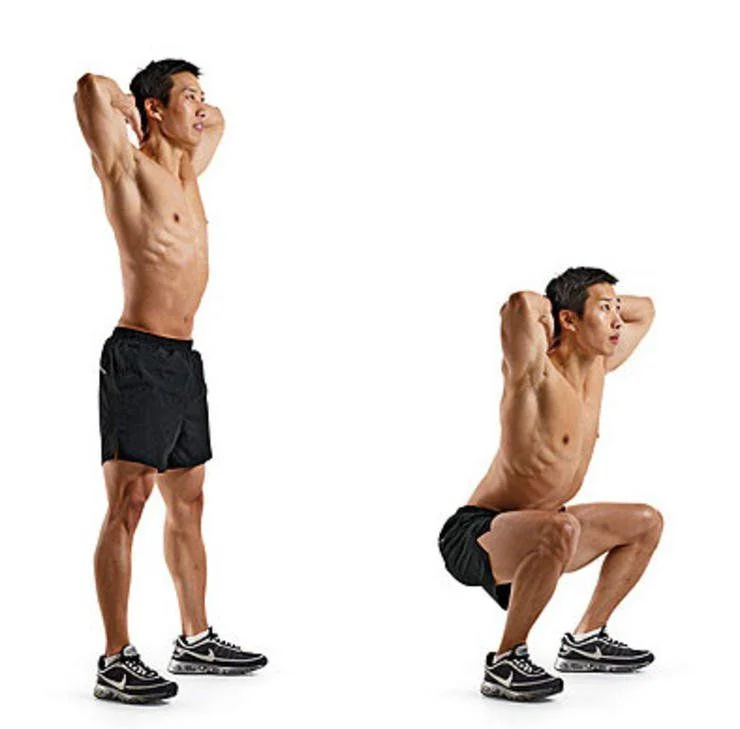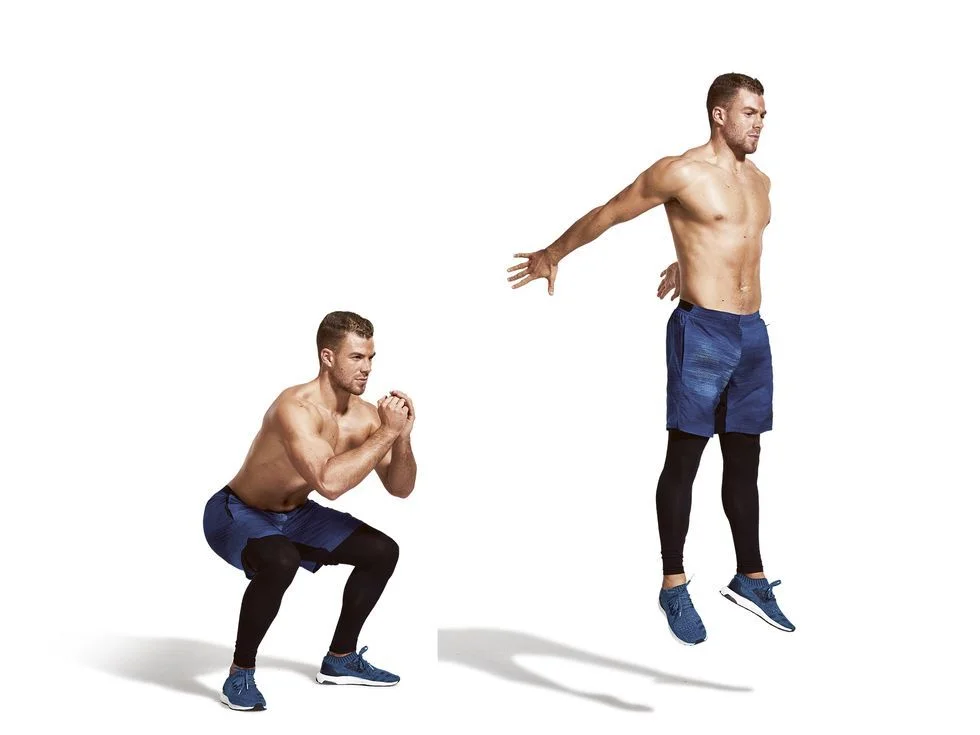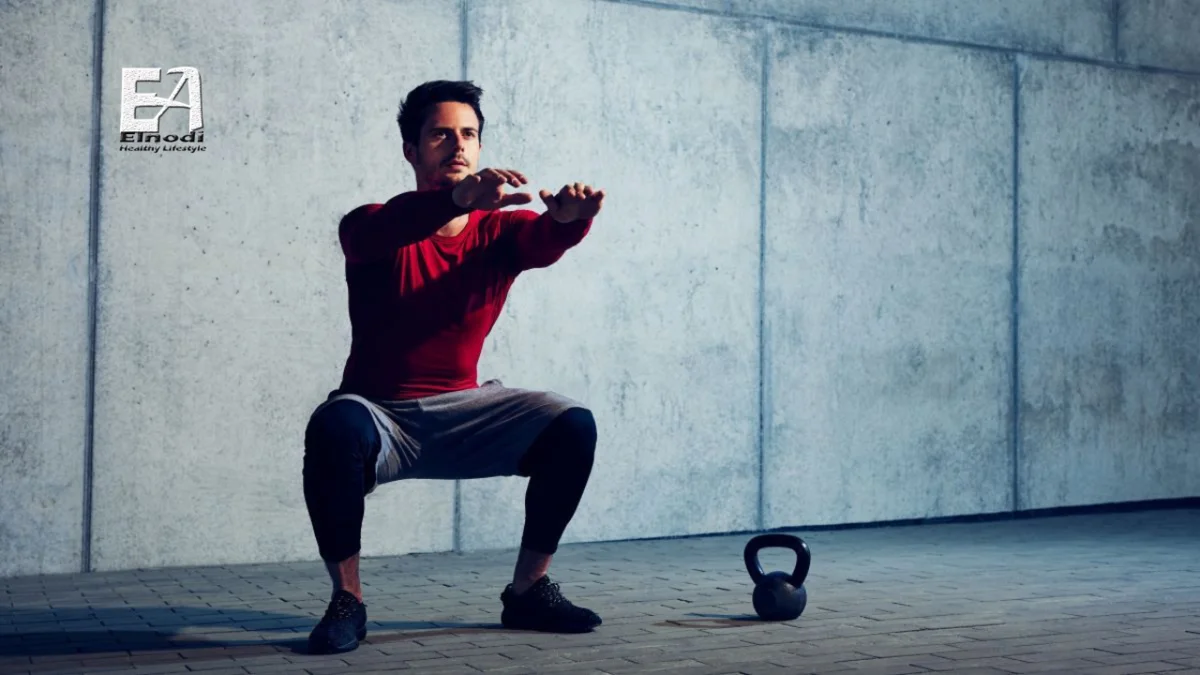Want to learn how to squat like a pro? This guide will teach you the proper form & guidelines so you can squat with maximum strength and efficiency.
A lot of weightlifting lore and misinformation is spread around due to how ungainly loading the backside looks in popular films and/or muscular athletes. Are you one of those people that’s been wanting to learn how to squat like a pro, but have been unable to find a good guide? Here are some tips on proper form and guidelines that will help you achieve squatting mastery. (1)
What muscles do squats work?
The squat is an exercise that can challenge almost every muscle in your body.
The obvious muscles targeted are those in the lower body, but to complete this compound exercise effectively, you must also activate muscles above your waist. (2)
A squat targets the following lower muscles:
- gluteus maximus, gluteus minimus, and gluteus medius (buttocks)
- quadriceps (thigh muscles in the front)
- hamstrings (thigh muscles)
- adductor muscle (groin)
- the hip flexors
- calves
The squat works your core muscles as well as your lower body. The rectus abdominis, obliques, transverse abdominis, and erector spinae are among these muscles. (3)
Back squats and overhead squats engage the muscles in your shoulders, arms, chest, and back. (4)
How to do a basic squat

The most basic sort of squat, also known as a bodyweight squat or an air squat, employs only your body weight for resistance. Weights, such as barbells or dumbbells, resistance bands, or yoga balls, can be used in squat variations.
When starting to squat, it’s best to work with a trainer to aid you with your form. The pressure in the squat should be distributed fairly evenly through your feet as you begin. This is also known as a foot tripod.
Imagine a triangle on your foot’s sole, with equal pressure applied to three areas: the front of the foot just behind the big toe, the front of the foot behind the pinky toe, and the heel.
To do a basic squat:
- Begin with your feet slightly wider than hip-width apart and your toes turned slightly out.
- Engage your abdominals and move your weight back into your heels as you push your hips back, keeping your chest up and out and the pressure even in your feet.
- Lower yourself into a squat until your heels lift off the floor or your torso begins to round or flex forward. Your form should decide your depth.
- As you stand back up to your starting position, keep your chest out and your core taut. At the top, squeeze your glutes.
- Perform 10-15 repetitions. Work your way up to three sets.
What are the benefits of doing squats?
The list of squat benefits is enormous, but here are seven essential benefits of doing squats to condense and highlight the best options.
1. Strengthens your core
Having strong core muscles can help with everyday actions such as turning, bending, and even standing. A strong core can also enhance your balance, alleviate low back pain, and make it simpler to maintain excellent posture.
A 2018 studyTrusted Source that compared core muscle activation during a plank with back squats found that back squats resulted in greater activation of the muscles that support your back.
Based on their findings, the researchers suggested that back squats be used to target the core muscles in order to reduce the risk of injury and improve athletic performance.
2. Reduces the risk of injury
When you strengthen your lower body muscles, you are better equipped to execute full-body motions with proper form, balance, mobility, and posture.
Plus, incorporating squats in your overall workout routine also helps strengthen your tendons, ligaments, and bones, which, according to the American Council on Exercise, may help reduce your risk of injury.
3. Crushes calories
Calorie burning is frequently associated with aerobic workouts like running or cycling. However, high-intensity compound motions like the squats can also burn a lot of calories.
According to Harvard Medical School, a 155-pound person can burn around 223 calories by undertaking intensive strength or weight training exercises like squats for 30 minutes.
4. Strengthens the muscles of your lower body
Some of your largest and most strong muscles are found in your lower body.
Your glutes, quads, hamstrings, adductors, hip flexors, and calves are responsible for practically every movement you make, from getting out of bed to sitting in a chair.
Squats and other strength training exercises can help build and tone the muscles in your lower body. When these muscles are in good shape, you may notice that you can move more comfortably and with less pain and that everything from walking to bending to exercising becomes easier.
5. Boosts athletic ability and strength
If you play a sport, including jump squats in your workout will help you develop explosive strength and speed, which can improve your athletic performance.
A 2016 studyTrusted Source investigated the effects of jump squat training done 3 times a week over the course of 8 weeks.
According to the study’s findings, jump squat training has the potential to increase several different athletic performances at the same time, including sprint time and explosive strength.
6. Variety helps with motivation
Once you’ve mastered the basic squat, you can experiment with a variety of squat variants. Squat variations serve to keep the workout interesting while also engaging different muscle groups.
Squats can be performed using only your body weight. They can also be performed with dumbbells, barbells, kettlebells, or medicine balls, as well as resistance bands or yoga balls.
7. Can be done anywhere
Bodyweight squats do not require any equipment. All you need is your body and enough space to lower your hips and sit.
If you’re short on time, doing 50 squats a day can still benefit several muscle groups: try doing 25 in the morning and 25 at night. Add 25 to the afternoon as you gain strength.
squat variations
Back squats

The back squat takes the traditional squat motion and adds resistance to the shoulders with a barbell. It’s often considered the “gold standard” when it comes to enhancing athletic performanceTrusted Source, as it requires the coordinated interaction of numerous muscle groups.
The back squat places an emphasis on the glutes and hips while still targeting the quads.
- Place a barbell in a squat rack at around shoulder height.
- Adjust the bar so that it rests behind your neck and over the top of your back. Take a firm grip on the bar.
- Step back with your feet slightly wider than shoulder-width apart to clear the rack.
- Squat down so that your hips are underneath your knees.
- After a brief pause, press through your feet and raise your hips to the beginning position.
Overhead squats

For an overhead squat, you can use a dumbbell or a medicine ball.
This version works your core, particularly your lower back. It also strengthens the muscles in your upper back, shoulders, and arms.
Your range of motion will be slightly different with this squat, so pay careful attention to your form.
- Standing tall, your feet should be somewhat broader than shoulder-width apart.
- Throughout the workout, keep the medicine ball above your head.
- Bend your knees and drive your hips back from a standing position, as you would for a typical squat. When your thighs are parallel to the ground, come to a halt.
- In your squat stance, take a little pause.
- Return to the beginning posture by pushing through your heels and squeezing your glutes at the top.
Jump squats

There is no equipment required for jump squats. This is a plyometric move, which means it’s a strong cardio exercise that challenges you to use your muscles to their full ability in a short amount of time.
The jump squat works your glutes, quadriceps, hips, and hamstrings while raising your heart rate.
Because this variation places additional strain on your joints, you must have healthy knees, hips, and ankles if you wish to try it.
- Stand tall, your feet slightly wider than shoulder-width apart.
- Squat down till your thighs are just above your knees.
- Lift your feet off the ground and propel yourself upward.
- Return to the squat position by landing with soft, bent knees.
Safety Tips
While squats are generally a safe exercise if done correctly, there are several considerations to take when performing them.
- Only lower yourself as far as you can comfortably go. Stop when you feel pain in your hips or knees and use that as your endpoint.
- Make sure you have a solid base. To begin most squat exercises, place your feet slightly wider than shoulder-width apart. A narrower stance allows you to focus the outside thigh muscles, but it also reduces foundation stability and puts extra strain on your knees.
- Keep your eyes forward. when it may appear natural to look down when performing a squat, you should keep your focus straight ahead. Pick an area in front of you to concentrate on to aid with this. This may assist you in maintaining a neutral neck position.
- Keep your posture upright. Avoid rounded shoulders and back. Maintain a straight spine in a neutral position, with your head neutral and not gazing up or down.
- Only lift what you can handle. If your form can’t handle it, don’t go heavy with the weight. You will profit more from the squat if you perform it correctly than if you raise too much weight. Lifting too much weight can also strain your lower back, hips, and knees, leading to problems.
- Activate your core. Maintain core muscular activation throughout the movement. Consider these muscles to be your internal weight belt that keeps everything in place.
Summary
Squats can help you develop strength and power, to name a few of the many advantages of including them in your workouts.
When done correctly, this functional exercise increases calorie burn, aids in injury prevention, strengthens your core, and improves your balance and posture.
Consider replacing the traditional squat with new versions to stay motivated. Not only will this keep your workouts interesting, but each new move will also push you.
If you have a medical issue or an injury, consult your doctor or a professional personal trainer before including squats in your workout program.
FAQS
What is a squat person?
what does squat mean?
Is it good to squat every day?
How many calories do squats burn?
Refernces
1. Comfort, P., & Kasim, P. (2007). Optimizing squat technique. Strength & Conditioning Journal, 29(6), 10-13.
2. Robertson, D. G. E., Wilson, J. M. J., & Pierre, T. A. S. (2008). Lower extremity muscle functions during full squats. Journal of Applied Biomechanics, 24(4), 333-339.
3. Work, W. M. D. S. Do Squats Make Your Butt Bigger? (Science-Backed).
4. Kompf, J., & Arandjelović, O. (2017). The sticking point in the bench press, the squat, and the deadlift: similarities and differences, and their significance for research and practice. Sports medicine, 47, 631-640.





